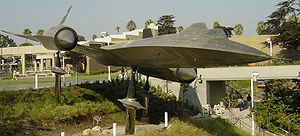
© WikimediaOXCART or CIA Lockheed A-12 Spy Plane.
Five former military personnel have come forward to reveal that they worked at the secretive Area 51 testing facility. While stationed at Area 51 they claimed they worked on top secret CIA and military projects including a supersonic jet that could travel at three times the speed of sound. The appearance and flight performance of the top secret OXCART program led it to being often mistaken as a UFO according to the whistleblowers. A
Los Angeles Times article with their testimonies concluded that the UFO mystery has been solved. Before celebrating the solution of the UFO mystery, it's worth considering some information that the
LA Times article did not.
The
LA Times article, "The Road to Area 51" was written by investigative author, Annie Jacobsen. She was able to interview the five retired military personnel due to a 2007 CIA decision to declassify fifty year old files concerning the OXCART or A-12 spy plane. This allowed the five to come forward for the first time to reveal their former classified activities. All revealed their roles in the CIA's top secret development and
testing of the OXCART as Lockheed's replacement for the U-2 for intelligence gathering flights over the Soviet Union. Satellites were still in development at the time so spy planes like the OXCART and U2 were a way of secretly gathering intelligence of Soviet operations. If a 1997 CIA History is to be believed, the UFO mystery was exploited as a convenient cover for spy planes like the U-2 and OXCART.
What is overlooked in Jacobsen's article is that many thousands of UFO reports predate the OXCART, U-2 and similar high performance spy planes. In the 1940s and early 1950s, many credible military personnel openly reported their experiences with UFOs that could easily out perform the most advanced fighter jets at the time. The UFOs could accelerate from low to supersonic speeds, become stationary, make right angle turns, and could be the size of aircraft carriers. UFO flight performance suggested some kind of antigravity technology which was at the time only a concept. In the mid-1950s, research on anti-gravity technology became highly classified and was removed from open source literature. Nick Cook from
Janes Defense Weekly believes that this is when the development of antigravity technology went black.
The steady leak of credible military testimonies since 1947 fed public interest in the UFO mystery until 1954 when Joint Army Navy Air Force Publication 146c was issued. It was now an offense for military and civilian aviation personnel to disclose to the public any UFO sighting that was under official investigation. A year earlier, in 1953, the CIA convened Robertson Panel recommended a public education program to debunk "flying saucer" reports (the earlier term for UFO) due to fear that the public could be manipulated by enemies of the U.S.
Finally, there are the numerous whistleblower reports about UFO crashes involving extraterrestrial biological entities and a government cover up. The 1947 Roswell Crash, for example, has well over one hundred credible witnesses who have come forward to reveal what they saw. These include the Public Information Officer, Walter Haut, who was responsible for the initial press release that a flying saucer had crashed. In a posthumously released
affidavit, he revealed how conflicting press releases were part of a cover up that had been authorized by senior Pentagon officials.
It appears that some government agencies are eager to promote the view that UFO reports are mistaken sightings of classified spy planes and military projects. If the OXCART was capable of Mach 3 in the 1960s and could be confused for a UFO, then it's natural to conclude that more recent UFO reports are a product of even more advanced classified projects. This is reflected in a March 2009 article in
Popular Mechanics on the January 2008 Stephenville UFO sighting. In its report,
Popular Mechanics concluded the Stephenville UFO was a classified USAF program and not an extraterrestrial vehicle.
Looks like something is brewing...
out of the PTB's control? Or is all
part of the "acclimation project"?